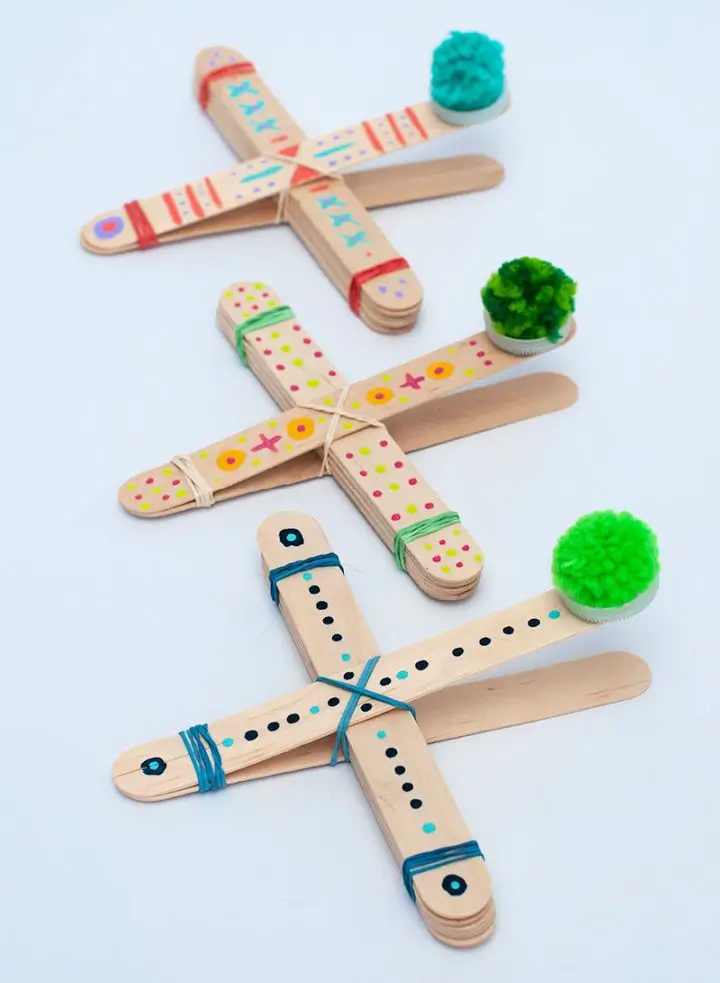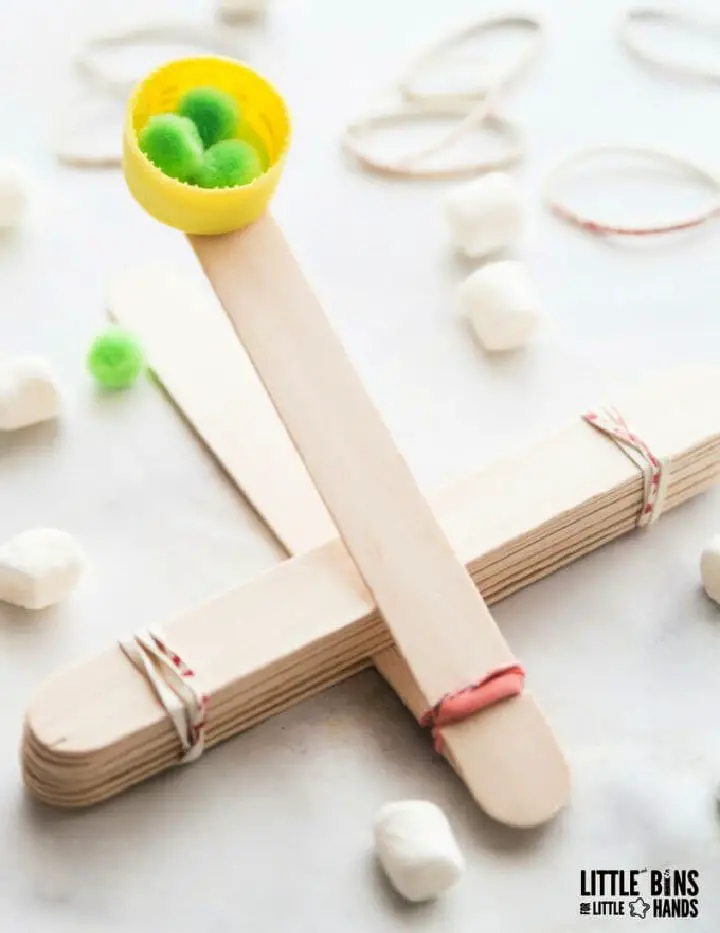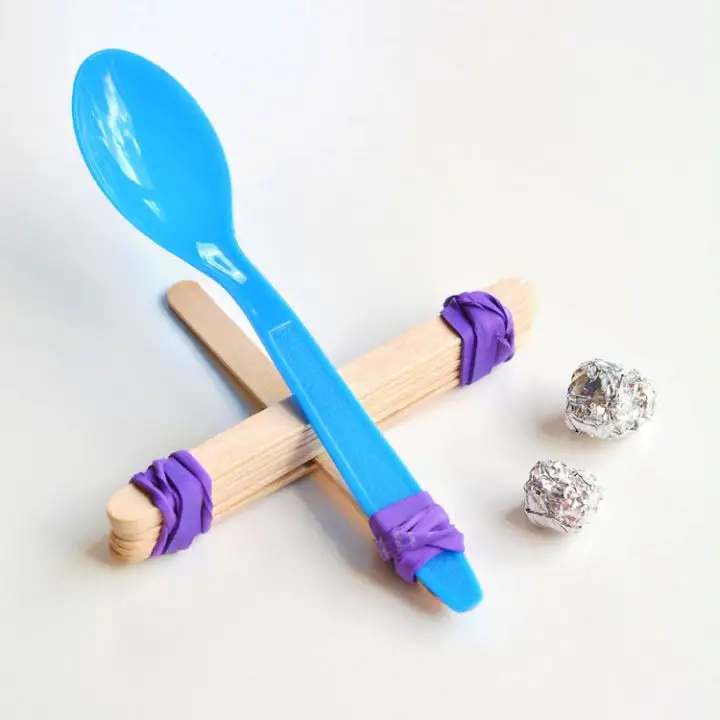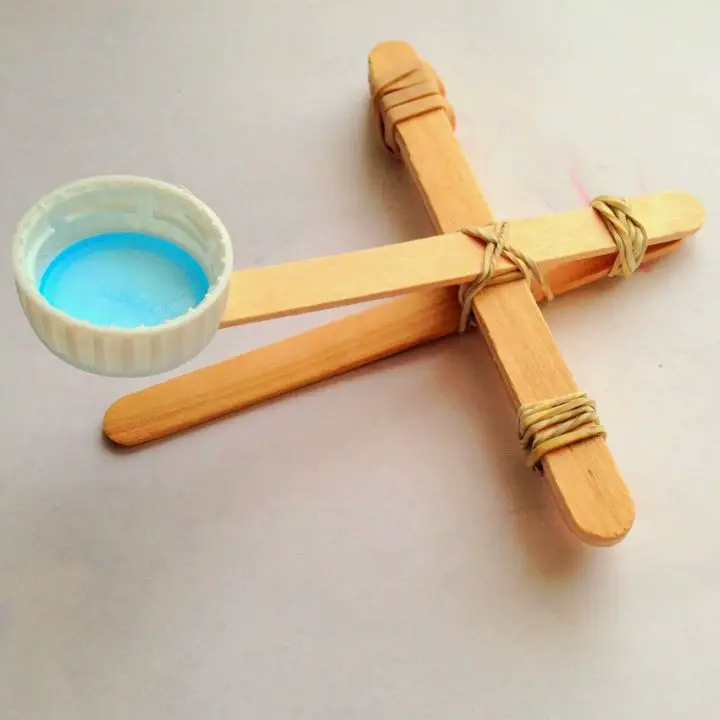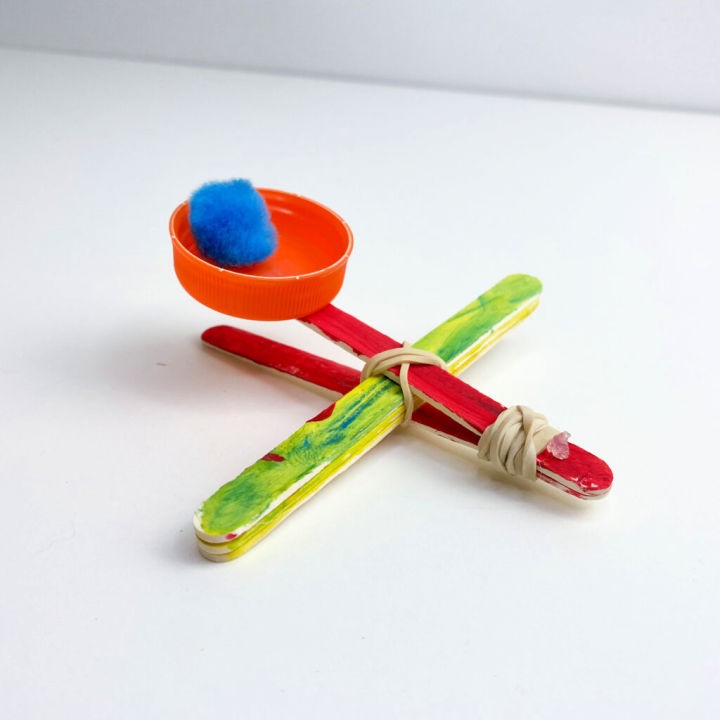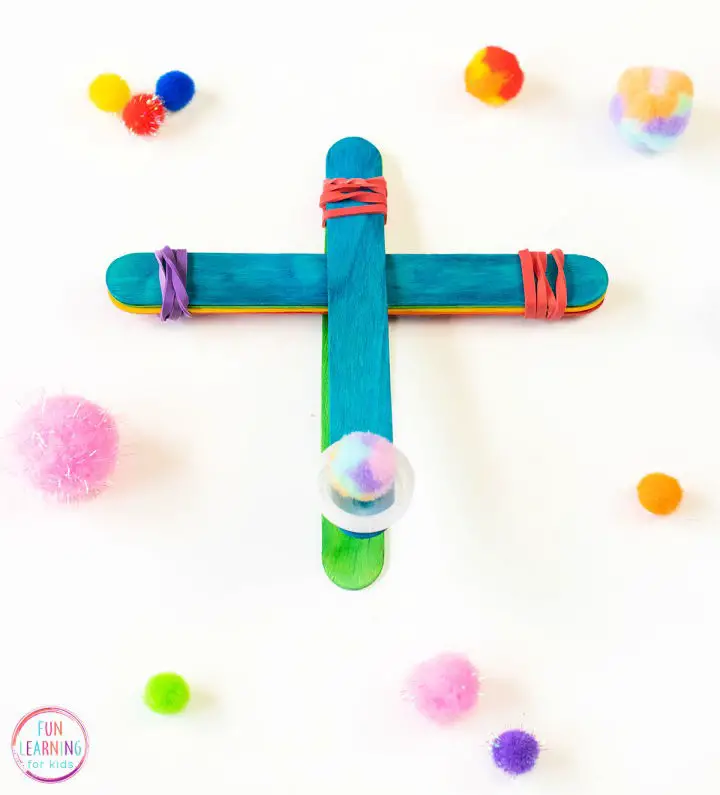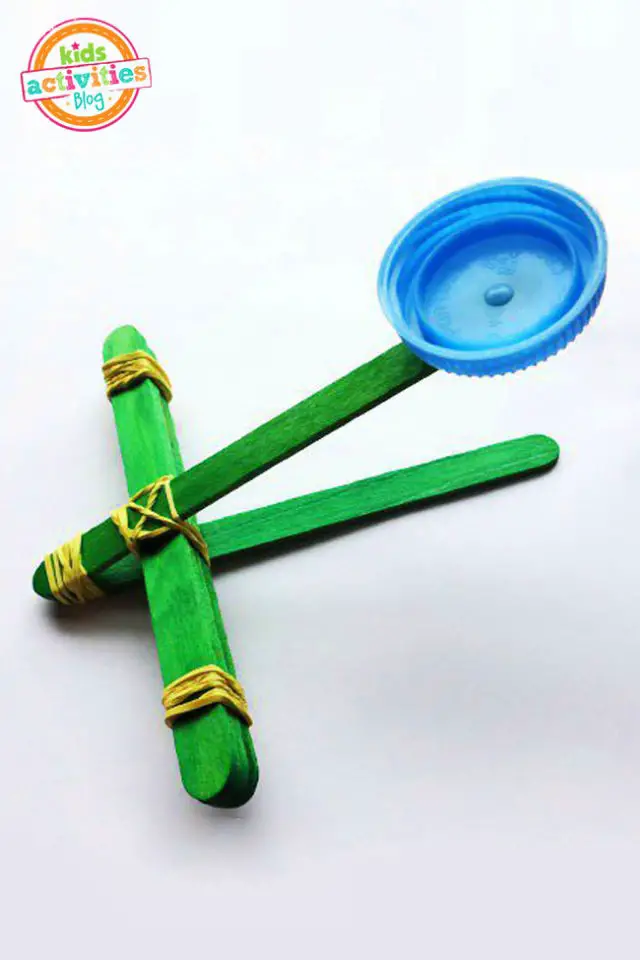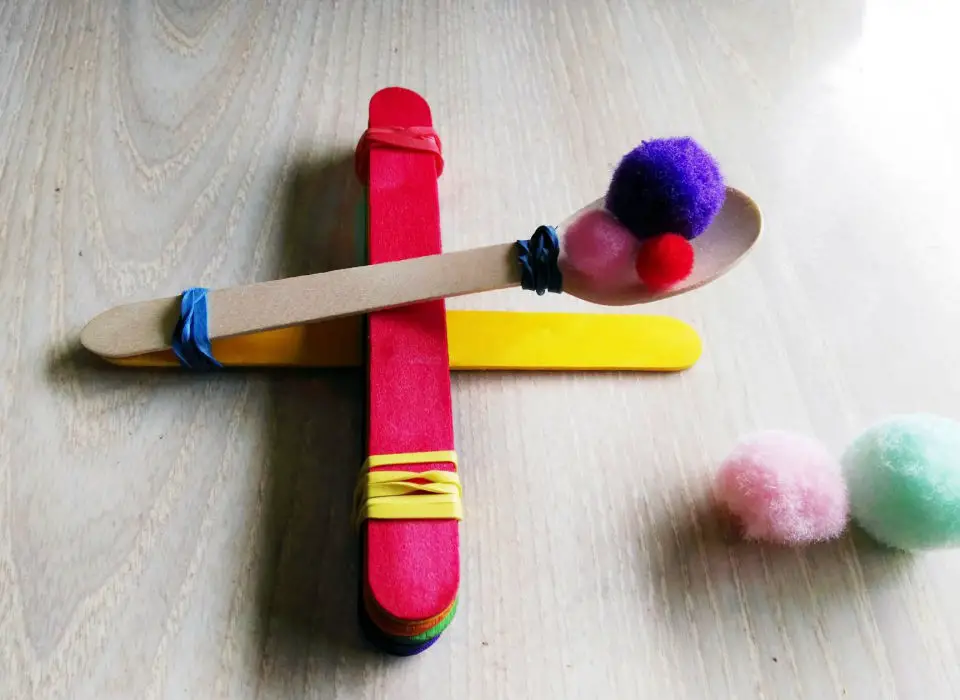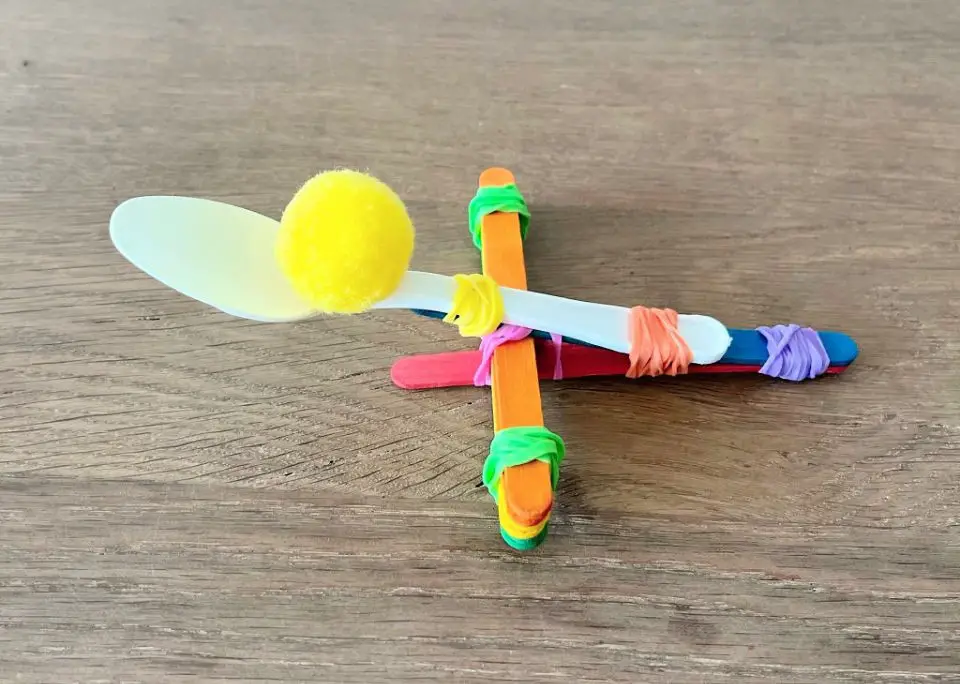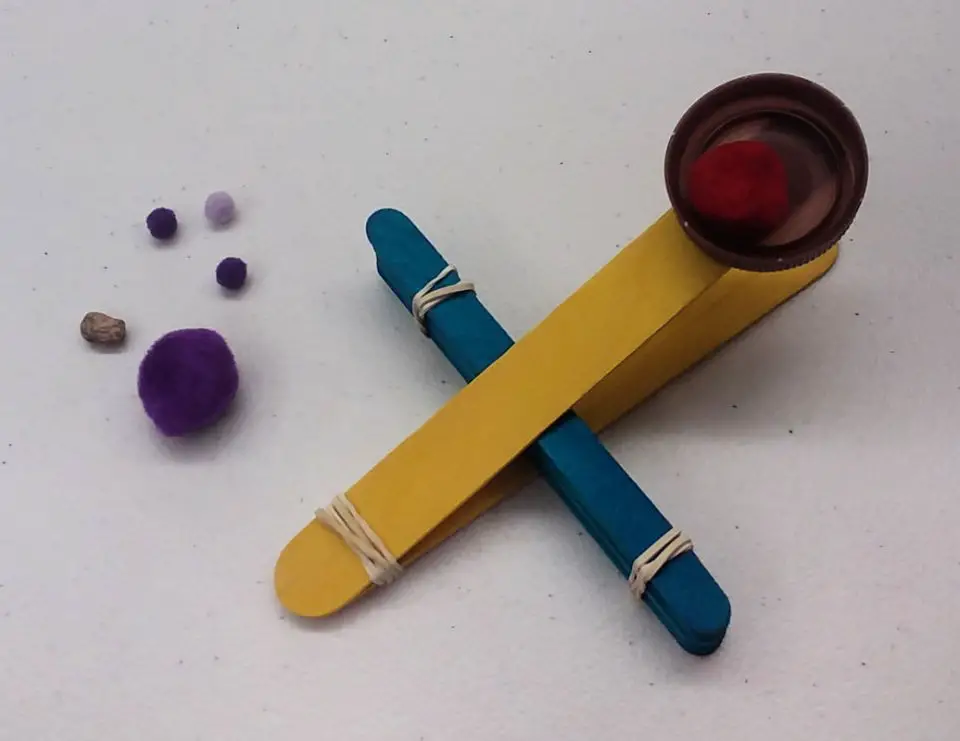Why Make a Popsicle Stick Catapult?
When you make a popsicle stick catapult, it’s not just a fun craft – it’s an opportunity to develop valuable skills and learn about important concepts. Here are some of the key benefits: The educational value is one of the biggest advantages. By building a catapult, you’ll be exploring fundamental principles of physics like leverage, tension, and propulsion in a hands-on way. This makes it an engaging STEM project that can help you develop your critical thinking skills.Creativity and innovation are also essential components. Designing and building a catapult encourages experimentation with different designs and ideas, helping you to think outside the box and find new solutions.Fine motor skills are another benefit of making a catapult. You’ll be picking up small items, using glue, and manipulating rubber bands, which can help improve your hand-eye coordination and dexterity.Problem-solving is also an important part of this project. You’ll likely encounter challenges along the way, but these require critical thinking and creative problem-solving to overcome. This helps you develop essential skills that will benefit you in many areas of life.When you work on a catapult with others, it becomes a team-building activity that encourages communication, collaboration, and mutual support. Sharing ideas and solutions can lead to a more successful creation and a greater sense of accomplishment.Finally, there’s the sheer fun and satisfaction of seeing your creation launch an object successfully. It’s a great source of entertainment and a reminder that learning can be enjoyable and rewarding.One of the best things about making a popsicle stick catapult is that it’s affordable and accessible. The materials you need are cheap and easy to find, making it a budget-friendly activity that anyone can enjoy.
How to Make a Popsicle Stick Catapult
Crafting your own popsicle stick catapult offers a unique blend of entertainment and educational value. By following this step-by-step guide, you’ll not only create a functional and fascinating device but also delve into fundamental engineering and physics principles. Whether you’re a teacher looking for an engaging classroom activity, a parent seeking a rainy-day solution, or simply wanting to celebrate National Inventors Day, this DIY project is sure to provide hours of creative enjoyment.
Materials Needed
To construct a unique DIY projectile, one can utilize a combination of everyday materials. Specifically, nine popsicle sticks, three bamboo skewers, and a few other items come together to form a makeshift tool for launching small projectiles. The materials needed include masking tape, a 2-inch piece of plastic drinking straw that has been cut with scissors, a small plastic cup suitable for containing the projectiles, and a rubber band. Scissors are also necessary for trimming the straw and tape as required.
Making the Base
To initiate the building process, focus on creating three triangular structures from your popsicle sticks. Begin by pairing up three sticks and securing them together at each end using a suitable adhesive. It’s vital that the stick tips don’t overlap, as this will significantly impact the stability of your catapult. Repeat this procedure until you have successfully constructed three triangles. Once these are in place, shift your attention to assembling the base of your catapult. This is achieved by placing the triangles alongside one another, forming a pyramid shape. Use 2-3 pieces of adhesive per side to guarantee that the foundation of your catapult is both sturdy and secure.
Building the Launching Arm
To prepare your DIY puppet’s arm, start by aligning three bamboo skewers and taping them together at one end, roughly two inches from the pointed tip. This joint will allow for movement of the straw, acting as a hinge when you insert it. Next, slide the cut straw onto the skewers, pushing it about an inch down. If two skewers fit comfortably inside the straw, that’s sufficient – just be sure to secure the straw with tape at one end to prevent it from slipping off. To add stability and rigidity to the arm, take two additional popsicle sticks and attach them perpendicularly to the skewers, one in front and one behind the middle area. Tape these securely in place to ensure your puppet’s arm remains sturdy.
Assembling the Catapult
To construct the arm of your catapult, begin by carefully bending the straw to create a hinge effect. Securely attach one end of the straw to the base using tape, allowing it to pivot smoothly. Next, wrap a rubber band around the base’s sticks and thread it through the other side, applying gentle tension that pulls against the pivot point of the straw. Be cautious not to overtighten, as this could compromise the catapult’s mechanism. Once the tension is set, carefully wrap the rubber band back around to secure it firmly. The slight resistance provided by the rubber band will be essential for launching projectiles successfully. Finally, attach the plastic cup to the outer end of the arm using tape, leaving enough stick exposed beyond the cup to grasp and control your chosen projectile.
Using Your Catapult
Launch a lightweight object, such as a cotton ball or small foam ball, by placing it in a cup and holding the base for stability with one hand. Next, use your other hand to pull back on the launching arm and then release it to send your projectile flying. Feel free to experiment with different angles and tensions to see how far you can get your objects to travel.
Video Tutorial
In addition to the written instructions that follow, a step-by-step video tutorial is available for those who prefer a visual learning approach or want to see the crafting process in action. This multimedia combination enhances understanding and makes it easier to replicate the project by providing a dynamic, multi-perspective view of the assembly process.
FAQS About Popsicle Stick Catapults
Creating a popsicle stick catapult offers a unique blend of creativity, engineering, and playfulness that appeals to individuals across various age groups. As you embark on this project, it’s natural to have queries and concerns. To facilitate a smooth and enjoyable crafting experience, here are some common questions and answers to address your needs.
What materials do I need to make a popsicle stick catapult?
To create your unique wind chime, you’ll need a variety of materials. Start by gathering popsicle sticks – at least nine are required depending on the design you have in mind. You may also want to collect bamboo skewers, which will come in handy for certain designs that require just three sticks. For holding things together, you’ll need some form of adhesive, such as masking tape or rubber bands. A plastic drinking straw, cut down to about two inches, will provide the perfect material for adding a playful touch to your wind chime. You’ll also want a small plastic cup or spoon on hand, which can be used to launch projectiles into the air (if you’re feeling adventurous!). Of course, no crafting project would be complete without the trusty scissor – this time, use it to cut the straw and tape as needed. Finally, have a rubber band ready to create tension in your design.
Can I make a popsicle stick catapult without bamboo skewers?
While it’s true that traditional catapults often rely on bamboo skewers, you can actually create an effective popsicle stick catapult without them. The key is to use multiple popsicle sticks to form the frame and lever arm, allowing for a sturdy yet flexible structure. Instead of relying on skewers as a pivot point, you can utilize rubber bands to generate tension and propel your projectiles.
What can I use as projectiles for my catapult?
When it comes to selecting projectiles for your indoor Nerf blaster battle, safety and ease of use should be top priorities. Opting for lightweight options like cotton balls, mini marshmallows, paper balls, or small foam balls ensures a fun and harm-free experience. Steer clear of hard or heavy objects that could cause injury or damage to yourself or the surrounding environment.
How can I make my catapult launch farther?
Mastering the art of catapult design requires a thoughtful approach to optimize performance. To achieve greater distances, consider the following adjustments:
Increase the tension on the rubber band, as higher propulsion power translates directly to increased range.
Adjust the angle of the launching arm to fine-tune the trajectory and ensure the projectile reaches its maximum potential.
Experiment with the weight of your projectiles, as slight variations can have a profound impact on overall distance. By carefully manipulating these variables, you’ll be able to squeeze out every last bit of performance from your catapult.
Is making a popsicle stick catapult safe for kids?
When it comes to building a popsicle stick catapult with kids, safety is paramount. As long as you’re there to supervise and provide guidance, this project can be a fun and educational experience. To ensure everyone stays safe, make sure to only use soft, lightweight projectiles that won’t cause any harm if they accidentally hit someone or something. It’s also crucial to teach children not to aim the catapult at people or fragile objects. Additionally, keep an eye on them while they’re using scissors or other cutting tools required for the project, as these can be a hazard if not handled properly.
How can making a popsicle stick catapult be educational?
By constructing a popsicle stick catapult, you can seamlessly integrate fundamental physics principles like leverage, tension, and propulsion into your creative process. Moreover, this project fosters essential problem-solving, critical thinking, and STEM literacy skills through an engaging and interactive experience.
Can I decorate my popsicle stick catapult?
Get creative and personalize your popsicle stick catapult by adding a dash of color and personality! You can use paint, markers, stickers, or any other art supply to bring out your inner artist and make the crafting experience even more thrilling.
How can I fix a catapult that’s not working properly?
When your catapult isn’t functioning as intended, there are several potential issues to investigate. Start by verifying that the base is stable and securely fastened, whether through tape or glue. Next, inspect the launching arm to ensure it’s properly attached and capable of pivoting smoothly. Adjust the tension on the rubber band, as inadequate or excessive pressure can significantly impact performance. Finally, conduct a thorough visual inspection to identify any misalignments that might be impeding motion.
20 Easy Popsicle Stick Catapult Designs (How to Make)
Unlock the simplicity and creativity of DIY crafting with 20 unique popsicle stick catapult designs. Follow easy-to-follow, step-by-step guidelines to bring your imagination to life in the comfort of your own home.
Making a Catapult Out of Popsicle Sticks
Unleash the inner engineer in both boys and girls by embarking on a creative adventure that’s equal parts fun and frugal. Constructing a mini-catapult using readily available materials such as popsicle sticks, hot glue, and household items is an excellent way to encourage hands-on learning. By following our step-by-step guide, you’ll be able to build a functional launcher capable of propelling lightweight objects with ease. This engaging project not only provides hours of entertainment but also fosters a love for science and innovation as you explore the mechanics behind this impressive little device. Whether you’re looking for an educational activity or a fun competition, our popsicle stick catapult is the perfect solution.
How to Make a Popsicle Stick Catapult
Want to inspire your kids’ curiosity and creativity while teaching them valuable STEM concepts? Try making a DIY popsicle stick catapult with Courtney’s crafts! This engaging project is ideal for young minds eager to explore the principles of engineering, mathematics, and science. With just a few simple materials like jumbo wood craft sticks, rubber bands, and bottle caps, you’re ready to start creating. Follow easy step-by-step instructions, let your children get creative with paint, and conduct fun experiments to see how far they can launch objects. This hands-on activity not only stimulates imagination but also nurtures problem-solving skills and understanding of physical laws in a playful environment.
DIY Popsicle Stick Catapult for Stem Activity
Want to ignite kids’ curiosity in STEM? Try a hands-on activity that’s both fun and educational! Little Bins for Little Hands presents an innovative DIY popsicle stick catapult that effortlessly introduces youngsters to fundamental physics concepts like energy, motion, and Newton’s laws. The simple yet engaging project combines creativity with scientific exploration, fostering an understanding of the underlying mechanics behind the excitement. A comprehensive step-by-step guide, accompanied by a helpful video tutorial, walks you through building your very own catapult, while a free printable worksheet assists in recording and analyzing your findings. This activity is perfect for classrooms or home learning environments, seamlessly blending play with education to help children grasp complex scientific ideas.
How to Make a Popsicle Stick Catapult
Engage kids in a fun and hands-on science project by creating a popsicle stick catapult with everyday items! This simple yet effective DIY project transforms ordinary household materials like lollipop sticks, wooden spoons, and elastic bands into a miniature marvel of engineering. By following this easy-to-follow guide, you’ll be able to build a device that not only teaches fundamental physics principles but also showcases motion laws, energy storage, and projectile launching in an entertaining way. Plus, with suggested safe and soft projectiles like marshmallows or pom-poms, the project is designed for safe play. With just a few basic materials and some creativity, you’ll be ready to embark on an educational adventure that combines crafting and basic mechanics.
Homemade Popsicle Stick Catapult
For those who delight in crafting and exploring, the One Little Project guide on creating a popsicle stick catapult is a winning combination of entertainment and education. This captivating activity not only provides an enjoyable experience but also introduces participants to fundamental physics concepts, making it an excellent way to learn by doing. Step-by-step instructions ensure seamless assembly, making this project suitable for a broad age range, whether you’re looking for a fun family activity or a thought-provoking educational exercise. Feel free to experiment with different projectiles and angles to explore the principles of potential and kinetic energy in a hands-on manner. With just a few simple materials – popsicle sticks, rubber bands, and a plastic spoon – you’ll be all set to embark on an unforgettable learning adventure.
Simple DIY Popsicle Stick Catapult
As kids embark on making their own popsicle stick catapults, they’re not only crafting a fun toy but also diving into fundamental principles of physics. This hands-on project requires minimal materials – just popsicle sticks, rubber bands, and a small container – yet yields significant learning opportunities. As children assemble their mini catapults, they’ll develop an understanding of levers and the conservation of energy, all while honing their problem-solving skills and creativity. With proper supervision, this engaging science experiment ensures safety while delivering a practical demonstration of potential and kinetic energy in an accessible and enjoyable way.
Popsicle Stick Catapult Instructions
Transform your kids’ creative potential with this engaging DIY project – a popsicle stick catapult! By combining STEM activities with fun, you’ll create a working model using everyday materials like jumbo craft sticks, colorful rubber bands, and a plastic spoon. Follow easy-to-follow instructions to assemble the catapult and watch as your little ones take pride in launching pom poms across the room. This hands-on experience fosters experimentation, friendly competition, and an introduction to physics and mechanics – making it perfect for both home and classroom settings.
DIY Popsicle Stick Catapult – Fun for Kids
Get ready to unleash a burst of fun with My Silly Squirts’ DIY popsicle stick catapult guide! This entertaining project brings together a few simple materials like jumbo popsicle sticks, rubber bands, paper shot cups, mini pretzel balls, and a hot glue gun to create an engaging launcher that’s perfect for a creative afternoon. Not only will you and your little ones have a blast, but this hands-on activity also helps develop their engineering skills as they work together to construct the catapult. The real fun begins when you challenge each other to see who can fling their pretzel ammo the farthest – it’s an experience that’s sure to bring laughter and excitement to everyone involved!
Making Your Own Popsicle Stick Catapult
Transform your child’s playtime into a STEM-filled adventure by crafting a popsicle stick catapult together! This hands-on project is an excellent way to introduce fundamental physics concepts like energy transfer and Newton’s Laws of Motion using everyday materials such as lollipop sticks, rubber bands, and a milk bottle cap. As kids design and build their own miniature marvels, they’ll develop problem-solving skills while exploring the wonders of engineering. To add a mathematical twist, encourage them to record distances and scores, turning playtime into a valuable learning experience. Feel free to experiment with different designs, from a shoe box catapult to a LEGO creation, and watch as your child’s creativity and critical thinking skills blossom.
Popsicle Stick Catapult Activity for Kids
Imagine unleashing your child’s inner engineer with a hands-on adventure that brings STEM concepts to life. The popsicle stick catapult activity from Fun with Mama offers a creative and playful way for kids to explore the basics of mechanical engineering and physics. By building their own catapults using everyday materials like craft sticks, rubber bands, and bottle caps, young minds will gain insight into the engineering process – planning, designing, building, testing, and evaluating. Perfect for K-12 students, this activity fosters problem-solving skills and can be adapted for individual or small-group participation. With its focus on creative experimentation and imagination, you’re about to launch your child onto an educational journey that teaches the fundamentals of machinery in a fun and engaging way.
How Do You Make a Popsicle Stick Catapult
Ignite your child’s curiosity with a DIY Popsicle Stick Catapult from Team Cartwright. This engaging project seamlessly blends fun and learning, introducing young minds to fundamental STEM concepts like potential and kinetic energy. With just a few simple materials – craft sticks, rubber bands, a plastic spoon, and soft projectiles like puff balls or mini marshmallows – families can create a homemade launcher that’s both entertaining and educational. As children design and test their catapults, they’ll develop problem-solving skills and grasp basic physics principles through hands-on experimentation, making it an instructive and enjoyable experience for all ages.
DIY Popsicle Stick Catapult With Binder Clips
Embark on a thrilling DIY adventure with stlMotherhood’s comprehensive guide to crafting your own popsicle stick catapult, suitable for both kids and adults. By combining basic materials like craft sticks, a binder clip, and a bottle cap, you can build a miniature catapult capable of launching projectiles an impressive 20 feet into the air. This interactive activity not only guarantees a fun-filled experience but also provides a hands-on approach to learning essential STEM principles. As you assemble your Binder-achtung 2000, you’ll combine creativity with physics for an unforgettable learning experience. Be sure to handle hot glue with care and select your projectiles thoughtfully for a safe and enjoyable catapulting adventure.
How to Do Popsicle Stick Catapult
Immerse yourself in an interactive STEM adventure by building a popsicle stick catapult with Fun Learning for Kids’ step-by-step guide. This hands-on activity is designed to ignite children’s curiosity and engineering skills, as they assemble a simple structure using everyday materials like craft sticks, rubber bands, and a bottle cap. As they fine-tune their creations for optimal launching performance, kids will naturally develop an understanding of fundamental physics concepts, such as potential and kinetic energy. By experimenting with launch angles and rubber band tension, young learners can further enhance their comprehension of force and motion. The instructions are straightforward and easy to follow, making the process enjoyable and stress-free. This engaging project offers a unique opportunity to combine learning with play, resulting in a memorable and practical science lesson.
Popsicle Stick Catapult Tutorial
Foster creativity and STEM skills in children by crafting a popsicle stick catapult together. This hands-on project from Mud Paper Scissors is perfect for developing fine motor skills and grasping fundamental engineering concepts. The activity involves constructing two sizes of catapults – regular and jumbo – using everyday materials like popsicle sticks, rubber bands, and a bottle cap. Not only does this DIY project provide a functional toy, but it also lays the groundwork for exciting science experiments. Experiment with different configurations, observe how variables impact launch distance, and encourage young minds to explore and learn through this enjoyable and educational experience.
DIY Catapult With Popsicle Sticks
Transform a typical afternoon into a STEM-filled adventure by constructing a simple popsicle stick catapult with your kids. This engaging activity, courtesy of Kids Activities Blog, provides a straightforward guide to creating this fun project. Perfect for children of all ages, the endeavour not only sparks imagination but also introduces fundamental principles of physics in an interactive manner.
With a minimal investment of materials such as craft sticks, rubber bands, and a milk cap, you and your little ones can construct a miniature catapult ideal for launching small objects like cotton balls. As they experiment with different variables to gauge the launch’s trajectory, kids learn through hands-on exploration. Prepare yourself for an enjoyable session of building and discovery that can foster a lifelong appreciation for science and creativity in your young learners.
Making a Popsicle Stick Catapult
Join forces with your little one to build an engaging STEM project – a popsicle stick catapult! This activity is perfect for kids aged 5-12 and fosters connection, problem-solving, and math skills. To get started, decorate a wooden spoon and gather simple supplies like popsicle sticks, rubber bands, and that spoon. Next, assemble the sticks into a base, secure them with bands, and attach the spoon to create your lever mechanism. Then, launch soft items like pom poms or marshmallows and experiment with adjustments to optimize distance. This hands-on craft effectively illustrates potential energy and gravity in a tangible way, making learning an interactive and enjoyable experience. It’s a project that seamlessly blends crafting with the fundamentals of physics, ideal for quality time with your child.
Easy DIY Popsicle Stick Catapult
Bring learning to life with the Pompom Launcher activity from STEAM and Make! This interactive project introduces children to fundamental physics and engineering concepts by guiding them through building their own miniature catapults using everyday materials like popsicle sticks, rubber bands, and a plastic spoon. As they construct these simple machines, kids explore the mechanics of levers, test different launching angles, and analyze the impact of varying forces on distance and accuracy.
Perfect for developing problem-solving skills and nurturing scientific curiosity, this STEAM Activity offers a fun and engaging way to explore creativity while gaining valuable insights into the workings of basic machines. As your kids measure distances, aim for targets, and customize their creations for a personalized touch, get ready to witness their excitement and learning!
How to Make a Lego Popsicle Stick Catapult
For a fun and educational activity that combines creativity with learning, look no further than the Lego Popsicle Stick Catapult project! This STEM-inspired craft encourages kids to engage in hands-on play while teaching them about science, technology, engineering, and math. By using everyday materials like popsicle sticks, rubber bands, a plastic spoon, and Lego bricks, children can build their own working catapult. As they launch their Lego pieces, they’ll develop problem-solving skills and learn to measure with precision – making this project perfect for rainy days or summer boredom. With its unique blend of fun and learning, this catapult activity promises an engaging experience that kids will love!
Make Your Own Popsicle Stick Catapult
Create an entertaining and simple popsicle stick catapult using everyday items, perfect for kids and adults looking to craft a fun projectile launcher. Our step-by-step guide ensures an enjoyable experience as you bring your creative vision to life. To start, gather 8 popsicle sticks, 5 elastic bands, a water bottle lid, and miniature marshmallows. Then, follow clear instructions to stack and secure the sticks with elastic bands, attach the lid using hot glue, and assemble your very own functional catapult. Once complete, place a marshmallow in the lid and watch it soar! This engaging activity not only fosters creativity but also provides a playful way to explore basic physics principles. We’ll have more crafting adventures for you tomorrow!
Quick DIY Popsicle Stick Catapult
Create a whimsical and interactive catapult using popsicle sticks, rubber bands, and a milk jug lid with Eveleth Public Library’s simplified instructions. Start by gathering two larger craft sticks or tongue depressors and eight smaller popsicle sticks, along with some small objects to launch, such as pompoms or beans. By stacking and securing these materials with rubber bands and a glue dot, you’ll construct a mini trebuchet capable of launching projectiles across the room. As you experiment with adjusting the flex, observe how it affects the trajectory of your launches, making for a hands-on learning experience that combines basic physics and engineering principles in a fun and engaging way.
Conclusion:
Mastering the art of creating 20 easy popsicle stick catapult designs not only yields a delightful and engaging activity, but also fosters creativity and innovation by sparking new ideas. By following straightforward step-by-step guides and leveraging common household items, you can bring these innovative contraptions to life. As an added benefit, this project is ideal for educational purposes, allowing learners to explore physics in a hands-on manner, making it a perfect endeavor for young inventors. To take your catapults to the next level, don’t be afraid to experiment with different materials and designs to see how you can enhance the distance and accuracy of your launches. With creativity and imagination at the forefront, get ready to craft and launch your very own popsicle stick catapult today!

